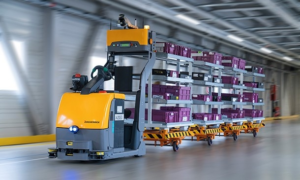
How DHL Aims to Remake Logistics with AI

What do semi-autonomous truck platoons, chat-bots, and fraud detection cameras have in common? They’re all part of a big plan that DHL unveiled yesterday to remake itself with artificial intelligence.
DHL is investing millions to take advantage of recent advances in machine learning that could help it optimize its sprawling $60-billion delivery service, which touches nearly every country in the world and involves 500,000 workers.
According to Ben Gesing, a project manager in DHL’s Innovation and Trend Research division, the Germany company is pursuing a multi-pronged strategy to utilize a variety of emergent AI technologies and techniques to help it cut costs, increase efficiency, and improve service levels across the company.
“In terms of data creation, processing storage and accessibility, the technology conditions for AI are very favorable,” Gesing tells Datanami. “Broadly speaking we think the future of AI and logistics is filled with potential.”
Here are some of the AI projects that DHL is currently working on:
Autonomous Vehicles – DHL is working on autonomous vehicles on three fronts, including the development of intelligent robotic workers in its own warehouses and air freight centers; the use of semi-autonomous trucks in the line-haul business; and “follow-me” robots used for last-mile route delivery in urban settings.
One of the more interesting uses of AI is the development of truck platoons in Europe, where anywhere from one to four autonomous semi-trucks follow a lead truck with a human driver down the road. By synchronizing acceleration, braking, and steering among the trucks, the platoon can boost freight capacity while minimizing costs, all without handing total control over to the AI program. DHL will be involved with testing a truck platooning in the UK next year with the British Transportation Research Laboratory and truck manufacturer DAF Trucks.
Chat Bots – DHL is looking into using autonomous customer service representatives by using deep learning-based natural language processing (NLP) technology, such as Amazon‘s Alexa, to automate some of the easier interactions between customers and DHL’s customer service representatives.
“Automating some of the low-level queries with chat bots can really increase the value of each interaction between customer and [human] agents by letting them focus on more high-level queries,” Gesing says. “That basically increases our throughput by a multiplier, not just a marginal increase.”
Computer Vision – DHL is exploring the use of deep learning-based computer vision algorithms for at least two use cases, including fraud detection and optimizing the loading of planes and trucks.
Some people try to defraud DHL by re-using shipping labels, which Gesing says could be automatically detected using cameras hooked up to fraud-detection algorithms. Similarly, computer vision could boost DHL’s capability to detect the size of packages so they can be stacked better.
“It doesn’t seem that interesting if you’re not in the logistics industry, but understanding how to best use your space and really optimizing the volume and capacity inside an aircraft or a truck” is important, Gesing says. “We’re getting better and better tools and technology to do that using AI-based vision technology.”

DHL’s Resilience 360 uses ML and NLP technology to help customers identify risks in their supply chains (Image Source: DHL)
Resilience 360 – DHL plans to infuse this cloud-based risk management tool with AI capabilities that will give its customers an early warning that something is amiss in their supply chains. This product uses sentiment analysis to monitor 8 million sources of data on the Internet, including social media, for anything that could signal a disruption, including unhappy customers and even labor unrest.
“For a lot of our B2B or automotive or manufacturing customers, they have very vast supplier networks,” Gesing says. “We proactive identify risky parts of the supply chain so our customers can plan downstream more effectively.”
DHL Global Trade Barometer –DHL feeds this this recently introduced tool with import/export data and data about containerized air and ocean freight, giving it a view into 75 percent of the world’s daily trade. It uses AI techniques to provide a three-month forecast on the direction of global trade.
“We have data scientists all over the world, internally and partners with external companies, to do different kinds of optimization of our network, things like predicting demand and capacity needed, or predicting delays in airfreight either by trade lane, by airline carrier, or by day of the week or day of the month,” Gesign says. “It gives us a directional assessment of where global trade is headed…to really get out ahead of our current daily operations to plan more effectively.”
Big Data to AI
Over the past several years, DHL has invested in exploiting recent innovations in areas like big data, augmented reality, and Internet of Things. In 2013, DHL published a Trend Radar report on big data, and yesterday it published another report called Artificial Intelligence in Logistics with support from its partner IBM, which you can download here.
AI is viewed as a big component of DHL’s digital transformation strategy, says Gesing, who works in DHL’s corporate innovation lab in Troisdorf, Germany, one of three innovation labs the company runs (the other is in Singapore, while the one in the United States is currently under development). “AI and machine learning are the extension of big data analytics,” Gesing says.
DHL’s board views AI strategically, but the innovation centers aren’t the only places where work on AI is being done. “We have a very broad digitalization strategy that comes from our corporate board,” Gesing says. “AI is inherently part of that. But really the best teams are the ones making productive use of this are really empowered to go learn and test and use this stuff.”
DHL isn’t doing a lot of core research into AI, because much of that work has already been done. Instead, it’s utilizing technology that has already been placed into the public domain by companies like Google, Amazon, Microsoft, IBM, and Facebook.
“Pretty much anyone who’s doing AI is benefiting from all these great open source tools and platform from all the tech giants,” Gesing says.
Related Items:
How Big Data Can Optimize Global Shipping
Airlines Embracing Analytics to Stave Off Disruption
UPS Delivers on Prescriptive Analytics
































